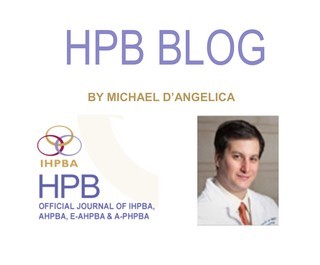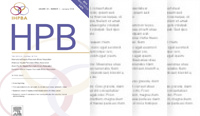International Hepato-Pancreato-Biliary Association
HPB Blog - August 2019

The August edition of HPB has some interesting papers that truly cover the full gamut of HPB diseases. The studies address a wide variety of issues related to H, P and B!
Four manuscripts focus on pancreas issues – 2 on post pancreatectomy complications and 2 on the management of pancreatic adenocarcinoma. Birgin, et al provide an interesting dive into the issue of post Whipple pancreatitis and its clinical relevance. They attempt to provide strict definitions of clinically relevant pancreatitis in this setting which will surely interest pancreas surgeons and inspire further looks at this relatively new take on post-operative complications. Floortje Van Oosten provide a systemic review of post pancreatectomy hemorrhage and suggest that angiographic management is the ideal way to manage this complication – and I agree! While the major problem with pancreatic adenocarcinoma is systemic dissemination, a group of patients will present with locally advanced disease without distant metastases. In a group of highly selected patients Holland et al report from a registry on 152 patients treated irreversible electroporation for locally advanced pancreas cancer. The outcomes are somewhat encouraging in that perioperative morbidity and mortality are acceptable however, the long-term outcomes highlight that even with good local control (6% local progression) people with this disease inevitably go on to die of metastases. Last on the pancreas topic is a study of isolated pulmonary recurrence after resection of pancreatic cancer by Groot et al from Johns Hopkins. Although it’s a minority of patients (13%) that recur in this pattern, their outcomes are quite favorable (median survival of 40 mths) and perhaps should be considered for locoregional treatments.
This month’s journal features 3 papers on post-operative pain control. Gavrilidis et al provide a review article on randomized trials evaluating wound catheters versus epidural analgesia. Three underpowered trials were identified and with a meta-analysis it was felt that despite higher pain scores functional recovery may be improved with wound catheters. Solis-Velasco et al report a retrospective analysis of consecutive cases and found that transversus abdominus plane blocks were associated with reduced pain and narcotic consumption after robotic distal pancreatectomy. In an analysis of Medicare patients in the U.S. Merath et al reviewed national data that show that only 7% of pancreatic and liver resections utilize epidural analgesia which was associated with a slightly longer length of stay.
Two papers focus on the operative management of colorectal cancer liver metastases. Xourafas et al studied the American College of Surgeons NSQIP database and in a propensity matched cohort found that the use of intraoperative ablation (as compared to liver resection alone) was associated with lower post-operative morbidity. In an interesting study from the ALPPS versus PVE trial (LIGRO trial), a subset of 24 patients were studied for early recurrence; while numbers were small there was no obvious difference in early recurrences among the 2 groups.
Four very interesting papers on HCC are published this month. Kobayahsi et al studied ICG clearance and expanding the criteria used to select patients for resection. While much of the world does not use ICG clearance the Japanese have been among the groups to champion its use and this paper further defines the limits of safety. In a systemic review, Chen et al studied the prognostic impact of microvascular invasion on outcome in patients with resected solitary small HCC. Despite the size of the tumor, microvascular invasion remains an important prognostic factor. In a somewhat similar study, Han et al show that both microvascular invasion and margin are both statistically independent prognostic factors after resection of HCC. Loveday et al,Toronto studied 31 patients who underwent portal vein embolization prior to planned resection of HCC and found that approximately 25% of patients have their operative plan changed – most commonly a more extensive resection or aborting the resection. This raises a serious issue of progression while waiting for hypertrophy and suggests that strategies to treat the tumor during this time may be beneficial.
I love to see transplant papers in HPB and this month there are 2 of them. Eman et al studied the UNOS database and analyzed transplant outcomes for HCC patients with HIV infection. The analysis suggests good outcomes. Diaz-Nieto et al from the Royal Free Hospital document nicely that the extremes of BMI are associated with higher rates of infectious complications after liver transplantation.
Finally, we arrive at the ‘B’. Cappelli et al retrospectively analyzed the long-term outcomes of percutaneous management of biliary stones and found that while there was acceptable success rates, long term success occurred in 68% of patients without a biliary stricture but only 36% of those with a stricture. In a combined series from the U.S. and Chile Vega et al studied T2 gallbladder cancers retrospectively and found that patients with T2b gallbladder cancer had much worse outcomes when treated with a repeat resection after incidental diagnosis. This furthers most of our belief that the first time around is likely the best time to treat gallbladder cancer.
In the end I found 2 papers that resisted broad generalization! Idrees et al using the U.S. National Cancer Database and support centralization of surgery for cholangiocarcinoma to high volume hospital. Surgery at high volume hospitals and adherence to the NCCN guidelines were associated with better outcomes. Since I help write the hepatobiliary NCCN guidelines this paper made me happy! Lastly, in a Dutch randomized trial published by Zwart et al for the Dutch Pancreatic Cancer Group, 3D vision was found to improve operative time and surgical performance on biotissue models. This is a very impressive multinational effort that really suggest that seeing in 3D is a good thing!
There is a lot to learn in this issue of HPB and I hope you enjoy reading it.
Michael D'Angelica
Corporate Partners
If you are interested in becoming a Corporate Partner of the IHBPA please contact industry@ihpba.org
Find out more


